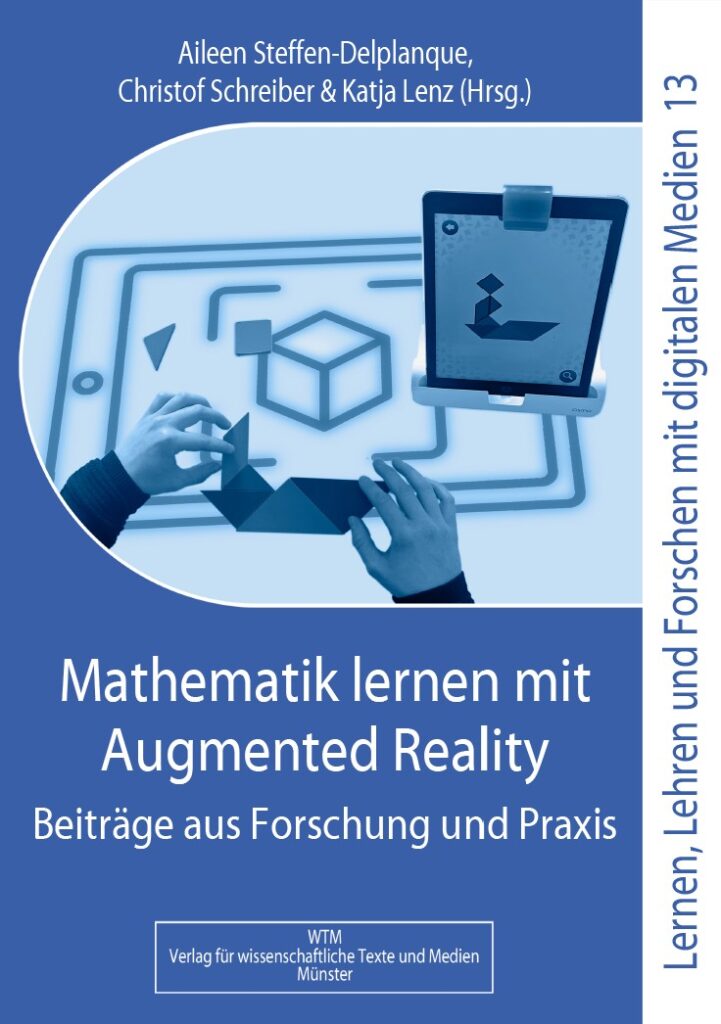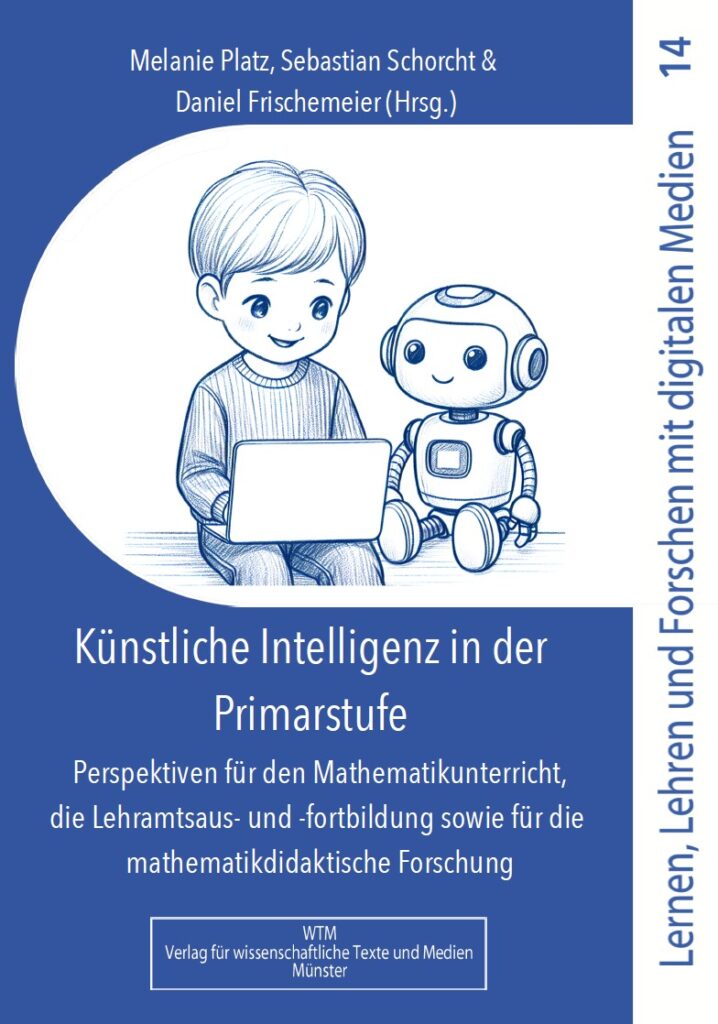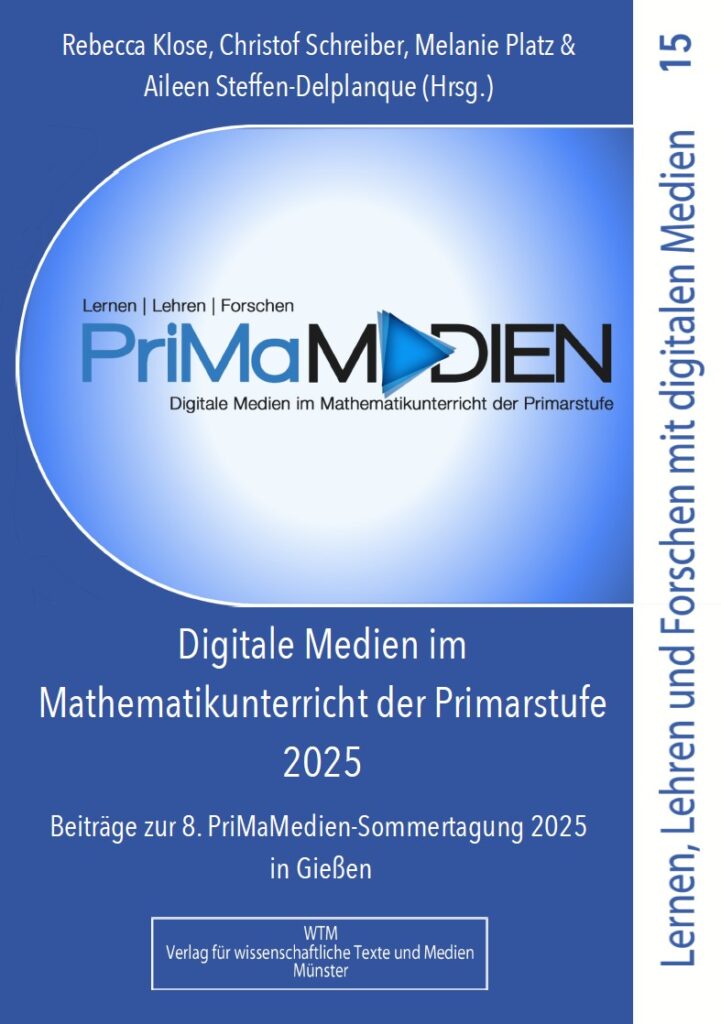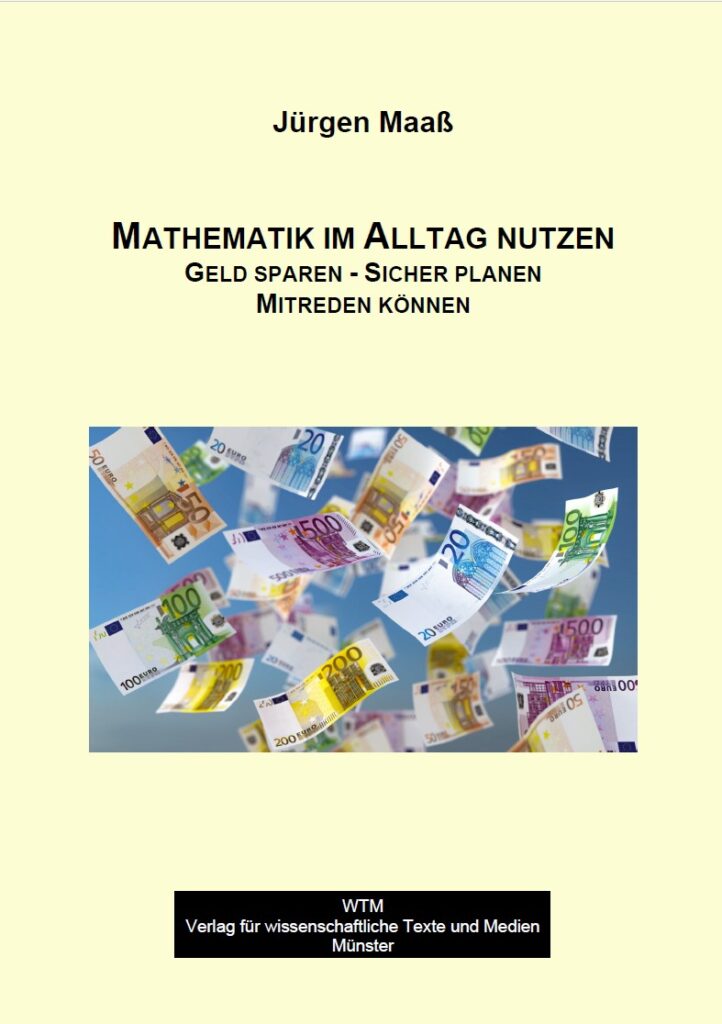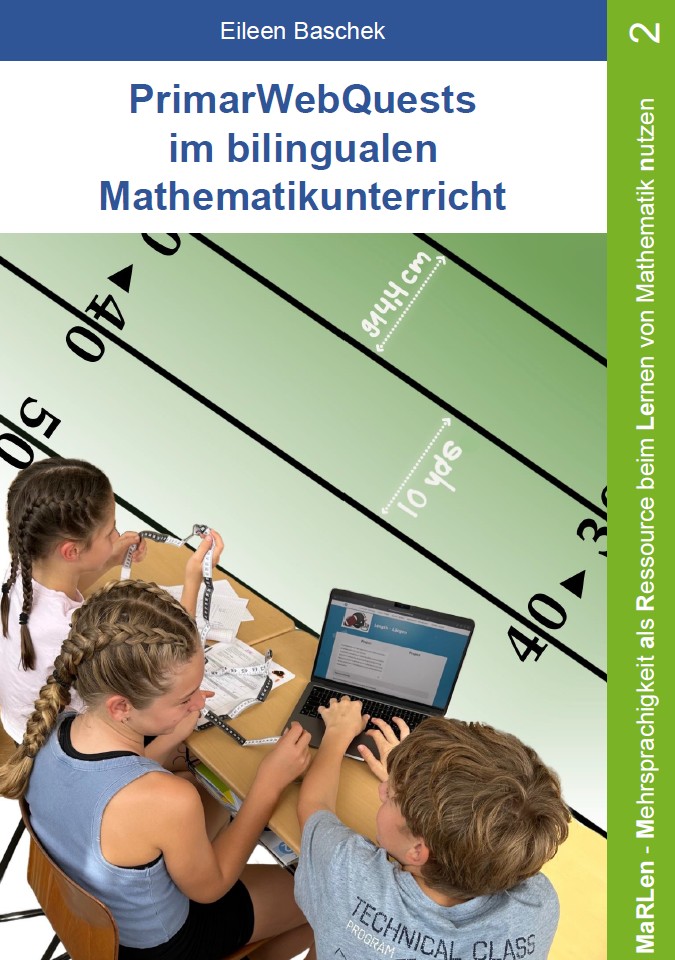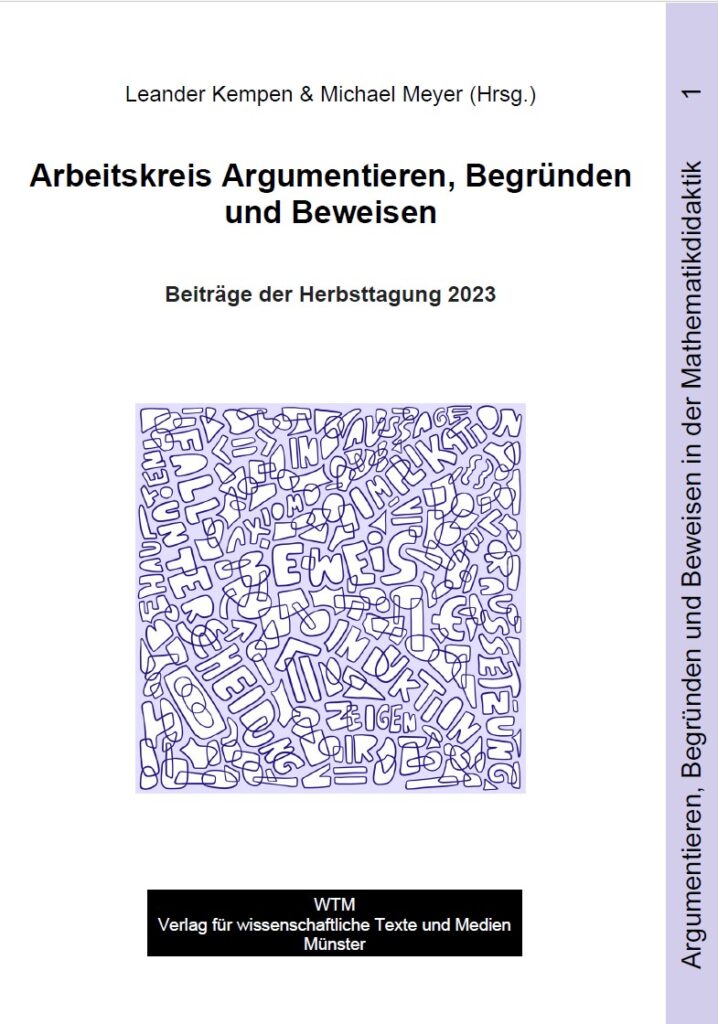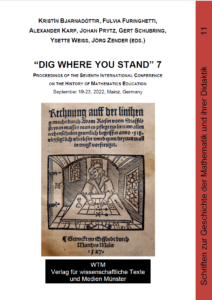 Proceedings of the Seventh International Conference on the History of Mathematics Education
Proceedings of the Seventh International Conference on the History of Mathematics Education
September 19-23, 2022, Mainz, Germany
Münster: WTM-Verlag 2023.
Ca. 380, Seiten, DIN 17 cm x 24 cm
978-3-95987-255-3 Print 51,90 €
978-3-95987-256-0 E-book Open Acces
Durch Klick auf den DOI-Link laden Sie den Betrag.
By clicking the DOI you will immidiately download the E-Book.
https://doi.org/10.37626/GA9783959872560.0
Für Bestellungen des gedruckten Buches bei edition-buchshop hier klicken.
Click HERE for Shop-Page or mail to kontakt@wtm-verlag.de
Abstract
The history of mathematics education is an interdisciplinary research area that is experiencing a significant development and this book presents recent work in this area. This book is the result of the seventh conference ICHME (International Conference on the History of Mathematics Education) that took place at Erbacher Hof, Mainz (Germany) from 19th to 23rd of September 2022.
Nowadays, the history of ed ucation is of the utmost importance for assessing the general development of the educational system(s) in which mathematics education occurs. Usually, the history of education is confined to history within a given civilization, country or nation. However, the quality of the research for a given nation is enhanced when situated among various specific cases, and comparative studies provide essential tools to broaden the perspectives to an international level. Moreover, mathematics, as a school discipline, has always functioned at the crossroads between general education and professional training, thus relating its teaching history to professional working environments as well. The 24 chapters in this book reflect this wide area of research.
Papers
Évelyn Barbin: The teaching of “indirect methods” by Gabriel Lamé, from the École polytechnique of Paris to the Institute of engineers of St Petersburg (1818-1827)
Abstract: Gabriel Lamé was a mathematician, he is well known for his work in mathematical physics, which he did at the time he became a professor at the École polytechnique in 1832. In this paper, we are interested in the young Lamé, engineer and mathematics teacher, about what he called “indirect methods” in geometry. Our main aim is to analyze the relations between his various teaching assignments and his mathematical conceptions. We examine two different contexts. Firstly, in a textbook written while he was a student at the École polytechnique in the years 1817-1818. Secondly, in the context of his and Émile Clapeyron’s teaching at the “Institut du corps des ingénieurs des voies de communication” [Institute of Transportation Engineers] in St Petersburg from 1820 to 1827.
Erste Seite: 1
Letzte Seite: 13
Durch Klick auf den DOI-Link laden Sie den Betrag.
By clicking the DOI you will immidiately download the paper.
https://doi.org/10.37626/GA9783959872560.0.01
=====================================================
Kristín Bjarnadóttir: Modernising Mathematics Teaching in the 1960s – Controversies in Nordic Cooperation
Abstract: Four autonomous countries, Denmark, Finland, Norway, and Sweden, established Nordic cooperation on modernising mathematics teaching in 1960, supported by the Nordic Council and OEEC, later OECD. Working teams wrote directives to teams writing experimental texts to be tested. The work continued until 1967. Soon controversies crept in. There were language problems, there were different opinions about modern mathematics concepts and symbols at compulsory level, and there were questions about authorship. The Swedes and the Danes turned out to be more active than the Norwegians and the Finns. The cooperation created useful discussion on mathematics curriculum, not the least for preparing legislation on nine-year compulsory school, stressing equal access to education for all, which was under development in all four countries, as well as in Iceland, the fifth Nordic country.
Erste Seite: 15
Letzte Seite: 28
Durch Klick auf den DOI-Link laden Sie den Betrag.
By clicking the DOI you will immidiately download the paper.
https://doi.org/10.37626/GA9783959872560.0.02
=====================================================
Mónica Blanco: The study of modern mathematics in the military course of mathematics (1753-1756) of Pedro Padilla
Abstract: In 18th-century Spain, military institutions played an essential role in the teaching of higher mathematics. Toward the end of 1750, an Academy of Mathematics was established at the Royal Guards Barracks in Madrid and was ruled by Pedro Padilla (1724-1807?) until it was dissolved in 1760. In 1753-1756, Padilla authored and published his Curso Militar de Mathematicas [Military Course of Mathematics] for the specific use by this Academy. According to the preface of his first volume, Padilla’s primary aim was to show that understanding the basic principles of each branch of mathematics could be useful to not only infantry and cavalry regiments, but could serve engineers, artillery and navy personnel. Besides, the publication of Padilla’s course was also an early initiative done so during a time when the tradition of dictating was still very strong. Of the twenty mathematical treatises that Padilla originally intended to develop, only the first five would be published in the end (in four volumes). The treatises IV and V are the most innovative, since they contain the earliest educational works on higher geometry and calculus published in Spain, respectively. The aim of this paper is to explore how the study of higher geometry and calculus was approached by Padilla in his course and, in particular, to identify the sources on which it could be based. The analysis of the treatises IV and V in Padilla’s mathematical course contributes evidences of the study of modern mathematics in 18th-century Spain.
Erste Seite: 29
Letzte Seite: 43
Durch Klick auf den DOI-Link laden Sie den Betrag.
By clicking the DOI you will immidiately download the paper.
https://doi.org/10.37626/GA9783959872560.0.03
=====================================================
Dirk De Bock: The late 1960s Belgian math war: “Papy-ists” versus “anti-Papy-ists”
Abstract: From September 1, 1968, modern mathematics was gradually introduced into the general streams of Belgian secondary education, starting in the first year (12–13-year-olds). However, some of the schools involved were given a one-year reprieve. Moreover, no decision had yet been made regarding technical secondary education. It gave hope to opponents of the reform: Possibly a temporary reprieve would become permanent, and mathematics in technical secondary education would not be modernized. It prompted a bitter struggle between “Papy-ists” (proponents of the reform led by Georges Papy) and “anti-Papy-ists”, a battle of Hernani between “moderns” and “ancients”. This battle was not only fought in academic circles but in the public arena with participation of all stakeholders (including parents). This Belgian math war at the end of the 1960s was finally won by the “Papy-ists”: Starting from September 1, 1969, all first-year secondary school students in Belgium were subjected to modern mathematics, without any exceptions.
Erste Seite: 45
Letzte Seite: 58
Durch Klick auf den DOI-Link laden Sie den Betrag.
By clicking the DOI you will immidiately download the paper.
https://doi.org/10.37626/GA9783959872560.0.04
=====================================================
Thomas De Vittori: Playing “As If” as a way to learn mathematics: the concept of equality in first grade in 1969
Abstract: Playing “As If” is perhaps one of the most commonly known game structures among children. In what Piaget has called symbolic play, or imitative play, children act as doctors, mechanics, merchants, and so on. In these moments, they put all their imagination into action, a creative imagination that Vygotsky considers to be one of the superior functions of the mind.
Based on a film made in 1969 in France in a first-grade class, this question of playing “As If” for mathematical learning is explored. In this session, during a fictional game based on the merchant’s game with a doll to be dressed, the students manipulate two sets of abstract symbols to (try to) construct the notion of equality in all its generality. Because the recording shows students actually in activity, this film constitutes one of the rare testimonies recorded during the modern mathematics era, a period that is sometimes decried but which, if we focus on the didactic analysis of the practices as they have come down to us, proves to be rich in new pedagogical approaches whose consequences have lasted long after the fall of this reform.
The film that is presented is part of a series intended for teacher training and is an example of a corpus of nearly one hundred reels (16 mm, with sound and color) edited between 1969 and 1972, which are currently being preserved and valorized. A large part of these documents shows classroom sessions, where active pedagogies are articulated with abstract mathematical notions but nevertheless approached in a very concrete way.
Erste Seite: 59
Letzte Seite: 70
Durch Klick auf den DOI-Link laden Sie den Betrag.
By clicking the DOI you will immidiately download the paper.
https://doi.org/10.37626/GA9783959872560.0.05
=====================================================
Hans Fischer: Making Cauchy’s Cours d’analyse “elementary”: Dirichlet’s Lectures on Series
Abstract: In the period between ca. 1820 and 1860, Cauchy’s theories on real analysis met with a mixed reception in Germany. On the whole, however, they significantly influenced the development toward modern analysis. In this paper contributions of Peter Gustav Lejeune Dirichlet, who fostered this process of transition through his teaching, are investigated, mainly with regard to his adaption of a part of Cauchy’s Cours d’analyse in a lecture course on series from winter semester 1840/41. In order to attain a better understanding for his specific didactic approach, Dirichlet’s course is compared with Schlömilch’s Handbuch der algebraischen Analysis (1845).
Erste Seite: 71
Letzte Seite: 81
Durch Klick auf den DOI-Link laden Sie den Betrag.
By clicking the DOI you will immidiately download the paper.
https://doi.org/10.37626/GA9783959872560.0.06
=====================================================
Fulvia Furinghetti & Livia Giacardi: ICMI in the 1950s and 1960s: The internationalization process and the emergence of Mathematics Education as a research discipline
Abstract: This paper aims to analyze the evolution of the objectives and fields of action of the International Commission on Mathematical Instruction (ICMI) in the period from its reconstitution as a permanent subcommission of the newly refounded International Mathematical Union (IMU) in 1952 to the presidency of Hans Freudenthal (1967–1970), who impressed a real turning point in the Commission’s activities. This period was crucial in the life of ICMI because of the need to better define its status as a subcommission and the concomitant events in politics, technology, research and society. The new ICMI as a subcommission of IMU depended on it both for the choice of members of the Executive Committee and for funding. The lack of precise Terms of Reference to regulate the relations between the two bodies produced friction that arose mainly from ICMI’s desire for greater independence from IMU. Furthermore, the Commission’s old agenda, which placed emphasis mainly on curricula issues and organizational aspects of mathematics teaching in the various countries, was now outdated.
In this paper we will focus in particular on the contributions of presidents Marshall H. Stone and André Lichnerowicz and their efforts to broaden the scope of ICMI both geographically and in terms of the agenda. We will also try to show how awareness of the weaknesses of the Commission progressively identified by the various presidents led to ICMI’s Renaissance. Finally, we will outline the main steps of the emergence of mathematics education as a new research field.
Our research is based on a selection of unpublished letters and documents belonging to the period 1952–1974 (from the IMU Archive and others), which made it possible to highlight unknown or lesser-known aspects of the history of ICMI.
Erste Seite: 83
Letzte Seite: 98
Durch Klick auf den DOI-Link laden Sie den Betrag.
By clicking the DOI you will immidiately download the paper.
https://doi.org/10.37626/GA9783959872560.0.07
=====================================================
Wendy Goemans & Dirk De Bock : Debates on axiom systems for school geometry during the 1960s: Relating the proposals by Artin, Choquet, Dieudonné and Papy
Abstract: During the first half of the 1960s, vivid debates on which axiom system is the most suited for teaching geometry in upper grades (15–18-year-olds) took place on a series of international meetings. Jean Dieudonné sparked up these debates with his slogan “Euclid must go!” at the 1959 Royaumont Seminar. In the following years, Dieudonné positioned himself at an extreme position in the discussion about the “best” axiom system for teaching geometry, as did Gustave Choquet, but the latter at a different, conflicting, side of the spectrum. Apart from several other mathematicians, Emil Artin mingled in the discussion with his contribution on three extreme points of view on teaching geometry. The controversy between Choquet and Dieudonné peaked in 1964 when they each published a book propagating their respective viewpoints. Only in 1965, Choquet and Dieudonné were reconciled through the efforts of André Revuz, whose proposition for teaching geometry was based on Georges Papy’s two-stage approach.
In this contribution, we examine Artin’s influence on Choquet and Dieudonné. It is the only shared reference both protagonists took up in their own work, and from a comparison of the content and structure of these mathematicians’ books, it is interesting to see on which parts there is an overlap. We note that Choquet’s axiomatic system and Dieudonné’s approach based on linear algebra are similar to, respectively, the first and second stage in Artin’s work. Also, we investigate how Papy was influenced by Artin, Choquet and Dieudonné, through an analysis of his “Mathématique Moderne” series. Finally, we discuss how Revuz reached the settlement through Papy’s position. By comparing the content of relevant sources, we shed light on the debates on axiom systems for school geometry during the first half of the 1960s.
Erste Seite: 99
Letzte Seite: 113
Durch Klick auf den DOI-Link laden Sie den Betrag.
By clicking the DOI you will immidiately download the paper.
https://doi.org/10.37626/GA9783959872560.0.08
=====================================================
Alexander Karp: Soviet Colleges Before WWII: How Entrance Exams Were Conducted
Abstract: This paper attempts to describe the system of college admissions that existed in Soviet Russia before the Second World War. The early post-revolutionary years saw a wholesale rejection of entrance exams. It proved necessary to return to them, however. The history of exams was part of a political battle, proving once again that mathematics education is closely connected with social and political history. During the pre-war years, certain ways of conducting exams became established, old exam problems returned and new ones appeared. Literature for students entering colleges reappeared, blossoming after the war. This paper is based on archival materials and the analysis of pre-war publications.
Erste Seite: 115
Letzte Seite: 129
Durch Klick auf den DOI-Link laden Sie den Betrag.
By clicking the DOI you will immidiately download the paper.
https://doi.org/10.37626/GA9783959872560.0.09
=====================================================
Jenneke Krüger: From ’stelkunst‘ to ‚which algebra?‘ Changes in Dutch school algebra
Abstract: In the Netherlands, from 1863 on, schools for secondary education in which mathematics, sciences and other subjects were taught to all pupils, were established in several towns. At that time algebra already was an art which was relatively wide-spread among Dutch mathematical practitioners and teachers of mathematics. Textbooks in Dutch, but also in English, French and German and journals were available to provide knowledge about algebraic techniques, simple exercises and problems. Thus when in 1870 a national mathematics curriculum was formulated, ideas about the elementary algebra to be taught in lower secondary school were reasonably well established. However, what algebra topics should be taught in higher secondary was less clear. During the next 150 years there were about seven relatively influential changes in the mathematics curriculum. In this paper the reasons for and effects on the algebra programme of the first three of these changes will be discussed.
Erste Seite: 131
Letzte Seite: 145
Durch Klick auf den DOI-Link laden Sie den Betrag.
By clicking the DOI you will immidiately download the paper.
https://doi.org/10.37626/GA9783959872560.0.10
=====================================================
Maria Célia Leme da Silva: History of school geometry in the early years: Brazil, 19th and 20th century
Abstract: This study aims to identify the interactions established between Brazil and foreign countries in the construction process of school geometry in the early years in the 19th century and at the beginning of the 20th century. To do so, we examined several sources: pedagogical programs, textbooks and pedagogical journals that circulated in Brazil in that period, as well as reports produced by Brazilian teachers who visited European countries on pedagogical missions at the end of the 19th century. The investigation was based on the theoretical postulate of the circulation of pedagogical knowledge, which was promoted by cultural agents, that is, educators, teachers, travelers, writers, exhibitors, etc. We aimed to analyze the appropriation processes regarding the knowledge received in Brazil by identifying its differences in comparison with the knowledge produced abroad (Burke, 2016).
Three examples of Brazilian appropriation of foreign content were analyzed in the incorporation of foreign proposals related to geometry teaching for the first years of school in Brazil. The three categories – drawing, handwork and tachymetry – selected for the appropriation analysis proved to be fundamental to understand a primary geometry teaching proposal. It is safe to say that school geometry in Brazil was fostered, collated and developed in an intimate connection with other disciplines or knowledge, or teaching methods, a result of close dialogue with several authors in a constant process of exchange, interchange, readings and interpretations of national and international experience, which reiterates the importance of pedagogical knowledge circulation (Fontaine, 2022).
Erste Seite: 147
Letzte Seite: 164
Durch Klick auf den DOI-Link laden Sie den Betrag.
By clicking the DOI you will immidiately download the paper.
https://doi.org/10.37626/GA9783959872560.0.11
=====================================================
Maria Rosa Massa-Esteve & Antoni Roca-Rosell: Teaching Engineers in Spain in the XVIII century: Analysing Mathematical Courses
Abstract: The analysis of the treatment of new mathematics in the training of engineers and gunners, taught in private colleges, academies and universities in the XVIII century, merits attention for a better understanding of the evolution of the history of mathematical education in this environment. We consider herein the activity of leading teachers and scholars who, despite being side lined in the common historiography of mathematics, played a major role in disseminating “modern” mathematical theories.
In Spain, as in other countries, the origins of “scientific” engineering settle in the Army, where officers acquired their training informally. After the War of Succession (1701-1714), the Spanish Bourbon Monarchy played a leading role in scientific and technologic development by establishing institutions to provide higher education for the officer corps, and in these academies mathematics constituted a core subject.
In 1739, a Royal Ordinance established the contents of the course in mathematics to be taught in the academies. This course, prepared by Pedro Lucuce (1692-1779), consisted of eight treatises with a total of approximately 2,200 pages devoted to the main fields of mathematics, including “pure” mathematics (arithmetic and geometry), and “mixed” mathematics (cosmography, statics, hydraulics, architecture, artillery, and fortification). The aim of this paper is therefore to analyse the treatment given to pure mathematics in this original course and to highlight some ideas which it contains. In addition, we make some reflections and provide evidence on the process of transition from workshop technical culture to school culture. We briefly present a notable case of this transition, the private mathematical course prepared by the Minorca artist Pasqual Calbó.
Erste Seite: 165
Letzte Seite: 180
Durch Klick auf den DOI-Link laden Sie den Betrag.
By clicking the DOI you will immidiately download the paper.
https://doi.org/10.37626/GA9783959872560.0.12
=====================================================
Antonio M. Oller-Marcén: Oerations with fractions in Spanish 16th century arithmetic texts
Abstract: Measurement processes play a central role in the historical genesis of rational numbers. As a consequence, and even if the use and treatment of fractions differed among cultures, it is not surprising that this topic is already found in the oldest preserved mathematical texts. As expected, one of the fundamental aspects that was consistently covered by the authors throughout the history was related to the performance of the four basic operations (addition, subtraction, multiplication and division) with fractions. In this context, many different approaches and presentations can be identified among different texts. During the 16th century, many textbooks with arithmetic content were published in Spain. They were written by authors with different profiles, and pursuing different goals. Hence, it makes sense to try to identify the possibly different ways in which these authors approached the treatment of fractions in their books. More particularly, in this work we consider the treatment of the four basic operations with fractions in arithmetic books published in Spain around the 16th century. We describe the very different treatments that we have identified according to the number of addressed cases, and their ordering and we discuss the differences according to variables such as the number of elements, or the type and nature of the objects involved in the operation. This allows us to compare the behavior of the different authors, and opens the question about the underlying motivations for their choices, and also about their possible sources and mutual influences.
Erste Seite: 181
Letzte Seite: 196
Durch Klick auf den DOI-Link laden Sie den Betrag.
By clicking the DOI you will immidiately download the paper.
https://doi.org/10.37626/GA9783959872560.0.13
====================================================
Johan Prytz, Linda Marie Ahl & Uffe Thomas Jankvist: Towards a sociological explanation of the success of the Back to Basics movement in Sweden, 1970–1980
Abstract: In this paper we seek to understand how and why the Back to Basic movement could have success in Sweden in the 1970s. The case is a state sponsored research and development project (PUMP) whose results had impact on popular textbooks. The study concerns the development process leading up to the implementation, but also the implementation phase. The analysis has a sociological perspective and involves Bourdieu’s concept of capital. Our material is interviews with key people involved in the PUMP-project. The main finding is that social capital, rather than academic and financial capital, appears to have been important in the development process. We also discuss how this finding can be used in future research
Erste Seite: 197
Letzte Seite: 212
Durch Klick auf den DOI-Link laden Sie den Betrag.
By clicking the DOI you will immidiately download the paper.
https://doi.org/10.37626/GA9783959872560.0.14
=====================================================
Anne Rahn& Susanne Spies: Arithmetic by manipulatives: a view through historical examples
Abstract: The use of manipulatives has become fundamental to the teaching of mathematics in primary schools. The materials used in mathematics education are surprisingly constant, even if the didactic guiding ideas have changed throughout history. The analysis of some still influential examples from the history of mathematics education since the 18th century on the basis of current didactic categories should serve to look at them from a new perspective and provide a framework for comparison.
Erste Seite: 213
Letzte Seite: 226
Durch Klick auf den DOI-Link laden Sie den Betrag.
By clicking the DOI you will immidiately download the paper.
https://doi.org/10.37626/GA9783959872560.0.15
=====================================================
Toni Reimers: Traces of the Impact of the Works of the Wittenbergian Mathematician Johann Friedrich Weidler on Textbooks and Academic Teaching of the 18th Century
Abstract: In the 18th century the term Mathematische Anfangsgründe appeared in the titles of introductory textbooks that are mainly designed to support the academic teaching of mathematics. They include allmost all the disciplines associated with contemporary mathematics. By historians, especially Abraham Gotthelf Kästner’s and Christian Wolff’s Anfangsgründe have been studied in the context of traditions of textbooks written in German. The aim of this article is to classify Johann Friedrich Weidler as one of the first generation of Anfangsgründe-authors and to get a first exemplary synopsis about his influence and impact in academic publishing and teaching.
Erste Seite: 227
Letzte Seite: 238
Durch Klick auf den DOI-Link laden Sie den Betrag.
By clicking the DOI you will immidiately download the paper.
https://doi.org/10.37626/GA9783959872560.0.16
=====================================================
Gert Schubring: The Royaumont Seminar 1959 and Freudenthal‘s Involvement
Abstract: As it is already common lore in the history of mathematics education, Hans Freudenthal had been invited to participate at the Seminar on New Thinking in School Mathematics, held in Royaumont in 1959, organised by the OEEC (later renamed OECD), but had rejected the invitation – and that he regretted later on this refusal as a great error, assuming he might have impeded the worst of what he then thought to be a wrong way for modernisation (de Bock & Vanpaemel 2019, p. 75). La Bastide-van Gemert was already able to shading and differentiating this common lore, by researching in Freudenthal’s Nachlass (La Bastide-van Gemert 2015). The focus of her analysis was to study Freudenthal’s individual acting regarding the invitation. As I had shown in my research upon this Seminar, which in fact launched the modern math movement internationally, the archive of the OECD had no longer documents of the preparatory stages of the Seminar; all that had been simply littered (Schubring 2014). Not only Freudenthal’s correspondence with the OEEC staff, but also a number of documents he received during the preparatory stages of the Seminar enable, however, to reconstruct somewhat the preparations by the OEEC and by a “group of experts”, which should assist them in elaborating the programme.
These documents allow not only to understand the concretisation of the conceptions for the Seminar, but also to remark that Freudenthal’s participation in the preparatory changes had instigated effects upon the Seminar conceptions. This contribution analyses these developments and elaborations. As a major surprise, one of the key elements of the lore is shown to be wrong. In a last section, I will report on my searches for information about the three West-German Seminar participants: Hermann Athen, Otto Botsch and Heinz Schöne.
Erste Seite: 239
Letzte Seite: 253
Durch Klick auf den DOI-Link laden Sie den Betrag.
By clicking the DOI you will immidiately download the paper.
https://doi.org/10.37626/GA9783959872560.0.17
=====================================================
Stela Segev: Hebrew authors in the 12th-16th centuries on teaching mathematics
Abstract: During the last decade, many works in Hebrew (manuscripts and printed books) from the 12th–16th centuries on scientific and especially mathematical topics have been deciphered. In these works, one can find mainly topics like arithmetic and geometry. Apart from the mathematical content, however, we can sometimes find (especially in each introduction but not only there), more information about other topics. Below are presented examples of the diverse information that can be found in the introductions to mathematical works written in Hebrew during the 12th–16th centuries, with a special focus on information that allows us to learn about the didactic views of the authors of these works. As research in teaching in general and research in mathematics education are relatively new research disciplines, these views are particularly interesting. Here we find evidence of didactic thinking long before the subject of mathematics teaching became a canonical university discipline. Scholars and students studying mathematics education will be interested in discovering that didactic issues in mathematics teaching are as old as mathematics itself. Special attention will be paid to Elijah Mizrahi’s Book of the Number (posthumous print in 1533), a unique figure among the authors of mathematical books in Hebrew from the 12th–16th centuries.
Erste Seite: 255
Letzte Seite: 267
Durch Klick auf den DOI-Link laden Sie den Betrag.
By clicking the DOI you will immidiately download the paper.
https://doi.org/10.37626/GA9783959872560.0.18
=====================================================
Yana Shvartsberg: Career Opportunities for Girls and Mathematics Education 1890-1920 in the US
Abstract: This study is dedicated to evaluating the effect of career opportunities prevalent among the female population in the United States on women’s mathematics education during the time high school education came to be accepted as a necessity for most children in the United States. The time period of 1890 through 1920 in the United States, called the Progressive Era, is known for its social, political, and education reforms. Shifting ideology and newly enacted laws for compulsory education sent students streaming to public schools, which in turn forced schools to accommodate a student population that was increasingly diverse, both in upbringing and in prior knowledge. Thus, in order to create a place for each child in the public school system, educators saw the solution in the diversification of education. The position of diversified education was to adapt school curriculum to meet utilitarian demands and to incorporate vocational, manual, commercial, and industrial studies into the public school system. Differentiated curriculum demanded the elimination of some subjects, and this movement specifically targeted mathematics, along with other subjects. The subjects that were eliminated differed, based on the professions foreseen by (or for) students, and since many of the vocations were gender specific, so was the education. This study will review data from multiple sources and perspectives—government, contemporary publications, and private manuscripts and letters written by prominent educators and historians—to analyze how high school mathematics curricula for girls were affected by the shifting job market demands.
Erste Seite: 269
Letzte Seite: 284
Durch Klick auf den DOI-Link laden Sie den Betrag.
By clicking the DOI you will immidiately download the paper.
https://doi.org/10.37626/GA9783959872560.0.19
=====================================================
Renate Tobies: Felix Klein (1849-1925): Symbiosis of History, Teaching, and Culture
Abstract: Based on recent studies, it is possible to explain the hitherto little-noticed link between the fields of history, teaching and culture in Klein’s teaching and research projects and the international impact associated with them. This symbiosis can be seen as part of Klein’s goal to reform mathematics education and bring mathematics into the consciousness of broad circles as a necessary component of culture.
Erste Seite: 285
Letzte Seite: 297
Durch Klick auf den DOI-Link laden Sie den Betrag.
By clicking the DOI you will immidiately download the paper.
https://doi.org/10.37626/GA9783959872560.0.20
=====================================================
Peter Ullrich: The concept of number by Karl Weierstraß and its first publication, viz. within a school program by Ernst Kossak
Abstract: Karl Weierstraß (1815–1897) presented his concept of real number and its generalizations in his lectures at Berlin university, but did not publish it in printed form. Instead of this, other mathematicians wrote publications on his theory, starting off with Ernst Kossak (1839–1892) in 1872, who was a teacher at the Friedrichswerdersche Gymnasium in Berlin then. This treatise appeared within the yearly program of Kossak’s school. By choosing this way of publication, he addressed rather teachers at other secondary schools or even a generally interested public than mathematicians at universities. In fact, academic circles reacted unfriendly: Hermann Amandus Schwarz (1843–1921) informed Weierstraß about flaws in it. Later on, Weierstraß himself expressed his negative views on it to Gösta Mittag-Leffler (1846–1927). Whereas these criticisms were only written in private letters, Gottlob Frege (1848–1925) directly attacked Kossak in his 1884 book on the foundations of arithmetic. Frege’s criticism, however, directly referred to the ideas and methods of Weierstraß proper, whereas the unfriendly remarks of Weierstraß and, in particular, Schwarz may root in a quarrel on an academic position.
Erste Seite: 299
Letzte Seite: 314
Durch Klick auf den DOI-Link laden Sie den Betrag.
By clicking the DOI you will immidiately download the paper.
https://doi.org/10.37626/GA9783959872560.0.21
=====================================================
Ysette Weiss: Concepts of mathematical giftedness in German schools: A cultural-historical approach
Abstract: The concept of mathematical giftedness and, accordingly, its promotion has been dealt with in different ways in Germany over the last 150 years. Institutional support has been shaped by economic conditions as well as by socio-political and cultural-historical factors, and by traditions of different thought collectives. We show that characteristics of the attitudes of the interest groups in mathematics education in the sense of Paul Ernest can also be explained by cultural-historical factors.
Erste Seite: 315
Letzte Seite: 330
Durch Klick auf den DOI-Link laden Sie den Betrag.
By clicking the DOI you will immidiately download the paper.
https://doi.org/10.37626/GA9783959872560.0.22
=====================================================
Sian Zelbo: A Re-examination of the Nineteenth Century French Influence on American Mathematics Education through Textbook Author Charles Davies
Abstract: Charles Davies was a prolific and influential nineteenth-century author of mathematics textbooks. Davies’s 1835 adaptation of Bourdon’s Élémens d’Algèbre is of particular interest because it forms part of a larger story about French influence on American mathematics education by way of the United States Military Academy at West Point. Prior studies have argued that French-American influence was undercut by the tendency of authors to alter the French analytic style of pedagogy for American audiences. This study adds to that line of research by giving more evidence of how this particular book originated and how the content was altered. It shows that Davies took credit for the translation of his subordinate, Edward Ross, and then simplified the book by removing modern mathematical concepts. Rather than spreading novel French ideas about mathematics, Davies’s 1835 algebra book and its many subsequent editions likely reinforced the status quo of American mathematics education for decades.
Erste Seite: 331
Letzte Seite: 345
Durch Klick auf den DOI-Link laden Sie den Betrag.
By clicking the DOI you will immidiately download the paper.
https://doi.org/10.37626/GA9783959872560.0.23
=====================================================
Bert Zwaneveld & Dirk De Bock: Piet Vredenduin: math teacher and more, trait d’union between the Dutch and Flemish mathematics teachers’ communities
Abstract: Piet Vredenduin (1909–1996) played a prominent role in the Dutch mathematics education community during the second half of the twentieth century: mathematics teacher, mathematics researcher which led him to a dissertation on Fraenkel’s Mengenlehre applied to number theory, author of mathematics textbooks for almost all sections of the secondary mathematics curriculum, mathematics teachers’ educator, participant in two innovating projects: teaching history of mathematics, and statistics and probability theory in secondary education, contributor and editor of the journal of the Dutch association of mathematics teachers. Last but not least, he played an important role in the implementation of the ideas as discussed at “Royaumont” (“New Math”). These are his main activities inside the Netherlands. Internationally we have to mention his role as a trait d’union, “a liaison officer”, between the Dutch and the Flemish communities of mathematics teachers: representing the board of the Dutch mathematics teachers association on many occasions in Flanders, contributing articles to the journal of the Flemish mathematics teachers’ association, informing the Dutch mathematics teachers about the developments in Flanders, and the Flemish teachers about the developments in the Netherlands, especially about the implementation of the recommendations of “Royaumont”.
Erste Seite: 347
Letzte Seite: 362
Durch Klick auf den DOI-Link laden Sie den Betrag.
By clicking the DOI you will immidiately download the paper.
